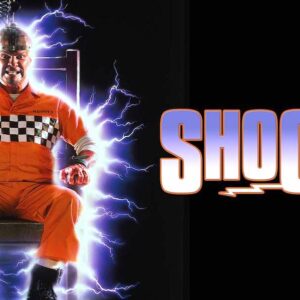Last Updated on August 29, 2024
Master of horror Wes Craven gave our favorite genre one of its greatest icons when he introduced Freddy Krueger in 1984’s A Nightmare on Elm Street, but he had very little to do with what happened to Freddy after that. As his character’s story continued, Craven had zero creative control over the Nightmares – aside from when he co-wrote the third film and wrote and directed the seventh film – and didn’t see much money from them. As he told Fangoria, creating Freddy gave him great credibility, but not a great payday. So when Alive Films asked him to create a new horror franchise that he would have control over and a financial stake in, he jumped at the chance. Alive gave him complete creative freedom, and he gave them Shocker (WATCH IT HERE), mixing ideas from some of his previous films, like A Nightmare on Elm Street and The Last House on the Left, with elements inspired by the likes of The Hidden and The Thing, and a desire to examine television’s place at the heart of modern culture – by creating a character who can travel through TV land. “A diabolical mass murderer who harnesses electricity for unimaginable killing powers.” Shocker was supposed to give us a new genre icon, jump-start a franchise, and earn Craven stacks of cash. Instead, it had a mediocre run at the box office and never received a follow-up of any kind. So WTF Happened to This Horror Movie?
Looking back at the production and 1989 release of Shocker, it’s obvious that the legacy of Craven’s earlier creation Freddy Krueger was hanging over this project like a cloud. It’s almost like the movie was made as a challenge to Freddy. Set reports and interviews conducted at the time were packed with references to the character; for example, one article said that Craven was aiming to “build a better Freddy” here, and in a “making of” featurette Craven straight-out said that the villain in this film was “designed to retire Freddy” and was “more exciting” than Freddy. The concept originated as a TV series idea that Craven had pitched to Fox, and the title of the series he wanted to make was The Dream Stalker, which is how Freddy is often described.
The Dream Stalker would have been a fitting title for the film up to a point. The story is set in the city of Maryville, which Craven intended to be in his home state of Ohio, but it was filmed in the Los Angeles area and never feels like anywhere other than L.A. Even though the production went through the trouble of putting Ohio license plates on all of the vehicles, they didn’t bother hiding the palm trees in the background of some of the locations.

When the film begins, Maryville residents are living in terror because their city has been the site of a nine month killing spree being carried out by the Family Slasher, a maniac who has battered his way through locked doors to slaughter entire families, claiming nearly thirty victims. Police are baffled, and the crime might never have been solved if local college football player Jonathan Parker didn’t develop a psychic connection to the Family Slasher. Through his nightmares, Jonathan is able to witness these crimes before they even happen. The images he sees eventually allow him to deduce that the Family Slasher is TV repairman Horace Pinker. Using his dreams as a guide, Jonathan helps the police apprehend the serial killer.
Musician Mick Fleetwood, who had recently taken an acting role in the Schwarzenegger movie The Running Man, auditioned to play Pinker, this character who was supposed to replace Freddy in our hearts and minds, but the role ended up being played by Mitch Pileggi. Pileggi would go on to play Walter Skinner on nearly one hundred episodes of The X-Files, but at the time he was an unknown and he turned out to be the perfect choice. He really shines in the scenes he has in the first 45 minutes. There is no explanation given for Pinker’s madness, no mythology built up around him, this guy is just a violent, sleazy, scumbag. It’s not hard to imagine him plotting to commit the sex crime of the century with Krug and the gang from The Last House on the Left. We never find out why he chose to wipe out entire families, but we do learn that he had a family of his own once, one that he beat relentlessly. Until the day his seven-year-old son shot him in the knee, giving him a permanent limp. Pileggi turns in an incredible, intimidating, unnerving performance as Pinker. In those first 45 minutes.
Then Shocker earns its title by executing Pinker in the electric chair and turning him into a supernatural-slash-electrical force that can travel through bodies and appliances. From then on he’s kind of a joke. The character, who has made some kind of electricity-based deal with the devil, turns into a quip machine for the second half of the film; his offer to take Jonathan on a ride in his “Volts-wagen” is one of the all-time worst groan-inducing one-liners. He was scary when he was flesh and blood, but when he gains supernatural abilities he does things like transform into a Vibe-O-Matic recliner and chant “I think I can, I think I can” while elongating his fingers and fingernails so he can plug himself into an outlet. It’s unfortunate. It took Freddy a few sequels to become overly comedic, but Pinker gets there within his first movie.
Between Pinker’s execution and the point in the film when he starts jumping between TV channels, he possesses the bodies of several people, giving some other actors a chance to play the character. Vincent Guastaferro of Jason Lives, Michael Murphy, Alice Cooper’s guitarist Kane Roberts, Janne Peters, Dendrie Taylor, Sam Scarber, and even Craven’s son Jonathan all get a turn, but the standout of the bunch is Lindsay Parker – who was nine years old when the film was released – as a little girl who develops a nasty disposition and a foul mouth when Pinker briefly takes control of her. One thing that becomes quite obvious when Pinker is possessing people who have guns – like Jonathan’s adoptive father, Lt. Don Parker – is that this guy is a lousy shot. It’s no wonder he chose to use a knife when he was committing his Family Slasher murders.

Once again, it’s up to Jonathan Parker to stop Pinker, and along the way he finds out that he has the psychic connection to the killer because he is Pinker’s long-lost son, the kid who shot him in the knee. Jonathan is played by Peter Berg, who doesn’t look anything like Mitch Pileggi. These days he’s primarily known as a director, his credits including Friday Night Lights, Hancock, Battleship, Lone Survivor, and Spenser Confidential, but he’s a solid actor as well. He made his character a likeable person and is capable of bringing some impressive intensity to some of his scenes. Jonathan is easy to root for as he dedicates himself to taking Pinker down, whether he’s a slasher or an electric ghost, and lucky for him, his girlfriend Alison is so special that she’s even able to give him assistance from beyond the grave after Pinker kills her.
It could be that one reason why Shocker didn’t catch on with a larger audience is that it’s a slasher that doesn’t follow the standard formula and doesn’t feature much in the way of the usual slasher movie clichés. The biggest cliché in here is the presence of a wisecracking killer. Beyond that, there are no instances of sex equaling death, there isn’t any gratuitous nudity – not even when Alison is seen taking a bath – and it kills off the character you might expect to be the Final Girl. Alison is the lead female, and even though she also claims to have a chaste relationship with her boyfriend – which doesn’t seem likely, given that he’s a college athlete who rents his own place and they’ve been dating on and off for a year – she still gets killed by Pinker just 25 minutes in. Alison was played by Cami Cooper, and Craven and Cooper were clearly endeavoring to give the character an ethereal quality during her early scenes. Mainly they tried to do this by having her whisper nearly every line she says. Even when she talks on the phone, she whispers. It’s kind of irritating.
Alison is one of several people killed by Pinker over the course of the film, but this also happens to be a slasher movie that doesn’t revel in the kills. The Shocker doesn’t even use his ability to manipulate electricity to kill many people. Most of the deaths are bloody slashings, and we’re usually just seeing the aftermath. That’s partially due to the way the death scenes were shot in the first place, but Craven also had trouble securing an R rating from the MPAA on this one and some gore effects had to be removed. In all, the MPAA demanded that thirteen changes be made throughout the movie before they would give Craven the R.
Craven seemed to have a great time during the production of this movie, especially since he was working with his largest budget to date, but there were some bumps in the road during post-production. The trouble with the MPAA was one bump, and another came when the cheaper method they were planning to use for the film’s special effects fell through and they had to spend three times as much as they intended to on special effects that had to be thrown together in just two weeks. Craven was never happy with how those effects turned out, and in the days when he was producing remakes of The Hills Have Eyes and The Last House on the Left he was also talking about remaking Shocker, mainly just to have a chance to tell the story with better effects. But even though the effects in the film look silly at times, they’re still fitting for the mind-boggling scenes they’re featured in.
Craven was also uncertain about the rock soundtrack, which was a sign of the involvement of executive producer Shep Gordon of Alive Films, who was manager of several musical acts, including Alice Cooper. While Craven might have felt that an orchestral score would have worked better for some scenes, the film’s fans love that soundtrack and have a lot of fun rocking out to the likes of Megadeth, Dangerous Toys, Bonfire, Iggy Pop, Dead On, and The Dudes of Wrath while watching Horace Pinker do his thing.

The most likely reason why Shocker only developed a cult following instead of becoming a big hit is the fact that the story jumps around all over the place and the film is extremely inconsistent in tone. What starts off as a promisingly chilling slasher goes off the rails and becomes an insane live-action cartoon; those first 45 minutes are very dark, and yet a goofy-looking strangled corpse seen early on serves as a warning sign for the silliness that lies ahead. A villain who starts off frightening and repulsive ends up chasing the hero through an episode of Leave It to Beaver. On the audio commentary, Craven admits that he was seeing the world in a different way while he was making this movie because he was going through a rough divorce and it had given him a dark sense of humor. At one point he wonders aloud if he made it too whimsical.
Shocker reached theatre screens on October 27, 1989, just in time for Halloween and just two months after the release of the latest Nightmare on Elm Street movie Craven had nothing to do with, The Dream Child. In the end, the icon the film had challenged, the one whose success Craven was chasing, beat Horace Pinker at the box office. Shocker’s domestic total was $16.5 million, and the fifth Freddy movie made just over $22 million. That’s less than half what the previous Elm Street movie had made a year earlier, but it was still enough to overcome Horace Pinker.
While Shocker wasn’t successful enough at the box office to kick off the franchise it was supposed to lead to, and Alive Films didn’t last much longer as a company, it’s tough to feel cheated by the lack of sequels. Are they really necessary when Pinker already goes through multiple movies worth of changes within this one’s 109 minutes?
Shocker quickly developed a solid cult following, but someone checking it out for the first time more than thirty years down the line will have to be accepting of the issues its fans see as part of its charm. The film is a mish-mash of ideas that doesn’t really hold together. The fluctuating tone and the ridiculousness of it all is what earns the film a place in the heart of some viewers, while repelling others.
For audience members who find Shocker’s scattered ideas and tonal shifts to be off-putting, the movie is a mess and has been ever since it was released. But if a viewer can appreciate the craziness it has to offer and overlook the dodgy effects, it’s just as entertaining now as it was in 1989.
WTF Happened to This Horror Movie is one of several shows that we have on our JoBlo Horror Originals YouTube channel. Check it out! And scroll down for some of our WTF videos.
Are you a fan of the battle between Horace Pinker (Mitch Pileggi) and Jonathan Parker (Peter Berg)? Crank up “No More Mr. Nice Guy” and let us know by leaving a comment below!



















Follow the JOBLO MOVIE NETWORK
Follow us on YOUTUBE
Follow ARROW IN THE HEAD
Follow AITH on YOUTUBE